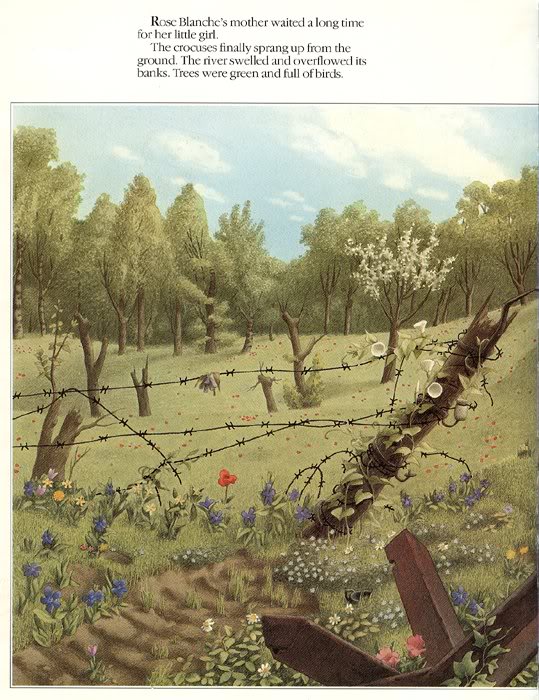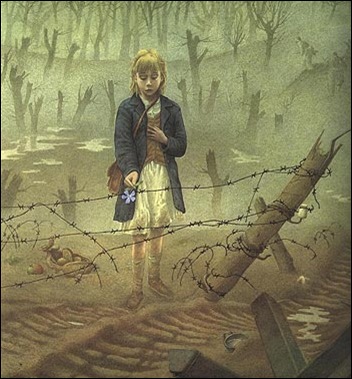Innocenti, R. (1985). Rose Blanche. Mankato, MN: Creative Education, Inc.
Reading Level: 3.2 and above
Plot Summary:
This is a story about the innocence of a child during World War II. Rose Blanche realizes that things are changing about her as she watches the trucks and soldiers come and go in a small town located in Germany. One day, she sees a little boy jump from the back of one of the trucks, but is the boy is quickly returned to the truck by the town mayor. Curiosity gets the best of the young girl as she wonders where the loud, stinky trucks full of people go. She decides to follow the truck after school one day only to find a world very different from her own. She discovers long wooden houses, electric barbed wire fences, and many cold, hungry children. Rose Blanche begins to sneak food to the young children after school every day. Then one morning, the people of the small town flee as a new group of soldiers arrive. Rose Blanche was already in the woods that day to find that the camp has been destroyed as a gunshot fills the air. As spring arrives, beautiful wildflowers surround the remains of the old barbed-wire fence.
Reading Level: 3.2 and above
Plot Summary:
This is a story about the innocence of a child during World War II. Rose Blanche realizes that things are changing about her as she watches the trucks and soldiers come and go in a small town located in Germany. One day, she sees a little boy jump from the back of one of the trucks, but is the boy is quickly returned to the truck by the town mayor. Curiosity gets the best of the young girl as she wonders where the loud, stinky trucks full of people go. She decides to follow the truck after school one day only to find a world very different from her own. She discovers long wooden houses, electric barbed wire fences, and many cold, hungry children. Rose Blanche begins to sneak food to the young children after school every day. Then one morning, the people of the small town flee as a new group of soldiers arrive. Rose Blanche was already in the woods that day to find that the camp has been destroyed as a gunshot fills the air. As spring arrives, beautiful wildflowers surround the remains of the old barbed-wire fence.
Literary Terms:
This book is well-known for its rich and realistic illustrations. One of the main visual elements observed in this book is the use of color. Throughout the book, the colors of the people and settings are very drab and gloomy, with the exception of Rose Blanche. The illustrator and author of this book used dark shades of greens, reds, browns, and grays throughout all the pages. His choice of color sets a melancholy mood which fits right along with the reality of sadness this story conveys The only brightness the reader will see is that of young Rose Blanche, who is dressed in a bright blue coat, pink shirt, white socks, black shoes, and a bright red bow in her blonde hair. Rose Blanche stands out against the cold winter settings and dreary-looking people. The luster of her curiosity, child-like innocence, and good-hearted compassion for the children living in the concentration camps is shown by this contrast in color. The written words of the story are simple enough for a child to understand, but the illustrations are so in-depth and powerful that they will remain with you after you have closed the book.
Another important literary device found in the book is the use of theme. There are parts of this story that are not explicitly stated by the author, but may be inferred by the reader. For example, it is implied that Rose Blanche has died when there is a gunshot heard in the woods and “Rose Blanche’s mother waited a long time for her little girl.” The last illustration of the book shows a bright-colored field full of beautiful wildflowers growing along the barbed-wire fences that were once part of the concentration camp. The purple flowers seen in this illustration are also found in a previous page where Rose Blanche is holding a single purple flower in her hand as she comes upon the foggy scene of the demolished concentration camp. This is not simply a story about war. The author’s meaning seems much deeper than that. There is a powerful underlying significance of the innocent mind of a child who doesn’t understand the bad things in the world happening around them. This book touches on ethics, compassion, and innocence as Rose Blanche finds herself in the midst of war and devastation. This emotional, haunting story has a theme that life isn’t always what it seems, especially in the eyes of a child.
This book is well-known for its rich and realistic illustrations. One of the main visual elements observed in this book is the use of color. Throughout the book, the colors of the people and settings are very drab and gloomy, with the exception of Rose Blanche. The illustrator and author of this book used dark shades of greens, reds, browns, and grays throughout all the pages. His choice of color sets a melancholy mood which fits right along with the reality of sadness this story conveys The only brightness the reader will see is that of young Rose Blanche, who is dressed in a bright blue coat, pink shirt, white socks, black shoes, and a bright red bow in her blonde hair. Rose Blanche stands out against the cold winter settings and dreary-looking people. The luster of her curiosity, child-like innocence, and good-hearted compassion for the children living in the concentration camps is shown by this contrast in color. The written words of the story are simple enough for a child to understand, but the illustrations are so in-depth and powerful that they will remain with you after you have closed the book.
Another important literary device found in the book is the use of theme. There are parts of this story that are not explicitly stated by the author, but may be inferred by the reader. For example, it is implied that Rose Blanche has died when there is a gunshot heard in the woods and “Rose Blanche’s mother waited a long time for her little girl.” The last illustration of the book shows a bright-colored field full of beautiful wildflowers growing along the barbed-wire fences that were once part of the concentration camp. The purple flowers seen in this illustration are also found in a previous page where Rose Blanche is holding a single purple flower in her hand as she comes upon the foggy scene of the demolished concentration camp. This is not simply a story about war. The author’s meaning seems much deeper than that. There is a powerful underlying significance of the innocent mind of a child who doesn’t understand the bad things in the world happening around them. This book touches on ethics, compassion, and innocence as Rose Blanche finds herself in the midst of war and devastation. This emotional, haunting story has a theme that life isn’t always what it seems, especially in the eyes of a child.
Curriculum Activity:
When I first read this book, I immediately thought about how closely this book relates to World History. A teacher could use this book as a reference when teaching about World War II and the Holocaust. An idea for a classroom activity would be to ask students to describe the scenes of this war, such as the soldiers, transportation, and concentration camps. Another activity may be to have students make a timeline of the events happening in the story as related to the war, beginning with the formation of the German army and ending with the arrival of soldiers from another country. Additionally, this book could also be used in conjunction with The Boy in the Striped Pajamas.
Common Core State Standards: I teach a Basic English 12 class to 12th graders with disabilities. If I were to use this book in my classroom, the following standards would be addressed.
CCSS.ELA-Literacy.RL.11-12.1 Cite strong and thorough textual evidence to support analysis of what the text says explicitly as well as inferences drawn from the text, including determining where the text leaves matters uncertain
CCSS.ELA-Literacy.RL.11-12.3 Analyze the impact of the author’s choices regarding how to develop and relate elements of a story or drama (e.g., where a story is set, how the action is ordered, how the characters are introduced and developed)
CCSS.ELA-Literacy.RL.11-12.5 Analyze how an author’s choices concerning how to structure specific parts of a text (e.g., the choice of where to begin or end a story, the choice to provide a comedic or tragic resolution) contribute to its overall structure and meaning as well as its aesthetic impact
BIG questions: How would you explain the concept of war to a child? How can a child view the world so differently than teenagers or adults do?
Connections: World War II, Holocaust, Fascism, Germany, concentration camp, wartime, hunger, innocence, compassion, death
When I first read this book, I immediately thought about how closely this book relates to World History. A teacher could use this book as a reference when teaching about World War II and the Holocaust. An idea for a classroom activity would be to ask students to describe the scenes of this war, such as the soldiers, transportation, and concentration camps. Another activity may be to have students make a timeline of the events happening in the story as related to the war, beginning with the formation of the German army and ending with the arrival of soldiers from another country. Additionally, this book could also be used in conjunction with The Boy in the Striped Pajamas.
Common Core State Standards: I teach a Basic English 12 class to 12th graders with disabilities. If I were to use this book in my classroom, the following standards would be addressed.
CCSS.ELA-Literacy.RL.11-12.1 Cite strong and thorough textual evidence to support analysis of what the text says explicitly as well as inferences drawn from the text, including determining where the text leaves matters uncertain
CCSS.ELA-Literacy.RL.11-12.3 Analyze the impact of the author’s choices regarding how to develop and relate elements of a story or drama (e.g., where a story is set, how the action is ordered, how the characters are introduced and developed)
CCSS.ELA-Literacy.RL.11-12.5 Analyze how an author’s choices concerning how to structure specific parts of a text (e.g., the choice of where to begin or end a story, the choice to provide a comedic or tragic resolution) contribute to its overall structure and meaning as well as its aesthetic impact
BIG questions: How would you explain the concept of war to a child? How can a child view the world so differently than teenagers or adults do?
Connections: World War II, Holocaust, Fascism, Germany, concentration camp, wartime, hunger, innocence, compassion, death




 RSS Feed
RSS Feed